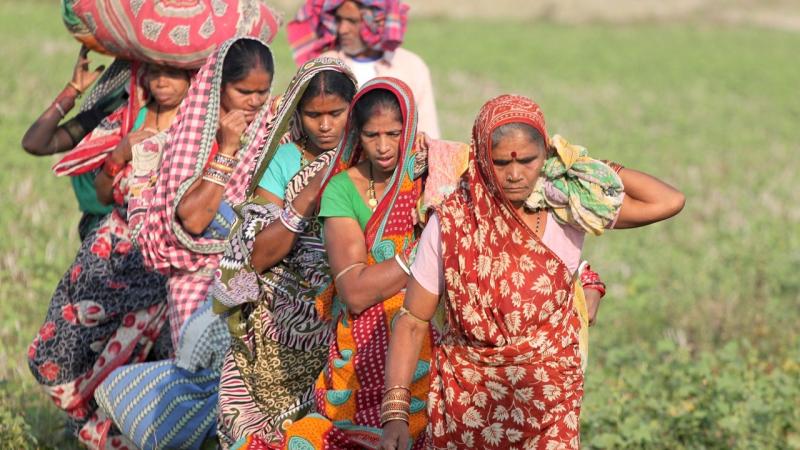
It's 5 a.m. in a remote village in Koraput district of Odisha. Sima Paroja joins other Paroja women as they walk towards their fields. Like other summer days, today's schedule looks frantic; they have their tasks lined up—transplant paddy, harvest millet and pluck vegetables. The fields look lush green with nutrition-packed crops—rice, maize, pulses, millet and vegetables. A perfectly-balanced, nutritious diet, if cooked!
However, here is the irony—these women are famished, and all that is pushing them forward is the rice and ambli (sour gruel of rice flour and tamarind) they ate the previous night. Back home, Sima's three starving kids lie waiting for their mom to return home. It's not poverty alone that's hurting them, but the lack of time for women like Sima to cook a meal! After a 12-hour-long work day, these women return home to their 'motherly' duties.

Tribal women in Koraput in Odisha in their farms [Image credit: Shiv's fotografia via Wikimedia Commons CC BY-SA 4.0]
In a village in Wardha district of Maharashtra, where Bt cotton is widely grown, the scene is a little better. Savita, a Gowari woman, toils in the fields harvesting cotton—not something she particularly likes as the smell of cotton gives her a headache—but does it for a living. Her husband works as a labourer too. When the parents are away, Savita's kids, unlike Sima's, don't stay hungry—they go to the nearby anganwadi, collect their bowl of khichdi (cooked rice and lentils) and stay fed. Despite this, Savita's children are malnourished.
This is the grim picture of women agricultural labourers in India that a new study, to be published in the journal Feminist Economics, paints. Prof Nitya Rao from the University of East Anglia, UK, and Dr S Raju, from the M S Swaminathan Research Foundation (MSSRF), Chennai, India, have explored how women’s work in agriculture affects nutritional outcomes for the family. The study found that although agricultural outputs have increased with women working in the farms, it has left them with little time to cater to the nutritional needs of their families and themselves, resulting in malnutrition.

A woman plucking cotton in a field in India [Image credit: Claude Renault via Wikimedia Commons CC BY-SA 2.0]
"Women's work in agriculture remains unrecognised. They don't have any rights or entitlements and confront a range of constraints to production, and also lack the support for reproduction. We wanted to study this and make it visible," says Prof Rao, talking about the motivation behind this study, in an interview with Research Matters. The study was part of the research consortium called LANSA (Leveraging Agriculture for Nutrition in South Asia) led by MSSRF, Chennai, and funded by the UK’s Department for International Development. It aims to decipher the links between agriculture and nutrition.
The researchers used data from 12 villages in two Indian districts—Koraput in Odisha and Wardha in Maharashtra—collected as a part of the Farming System for Nutrition study. The data has details about the socio-economic status, livelihoods, farming and agricultural practices, and diet of about 150 households in each district, collected through surveys. The researchers also gathered data on how women in these villages spend their day during different agricultural seasons—planting, harvesting and the lean period where there is little cultivation. This data includes the time spent on productive activities like paid domestic services, market-based work and work for self-consumption; reproductive activities like unpaid domestic work, care and voluntary work; and finally, leisure and non-productive activities.

Tribal women in a village in Odisha [Image credit: JudaM via Pixabay]
Caste and agricultural seasons affect nutrition
The study found that on average, women spend more time on productive and reproductive tasks than men. In both districts, women spent about three-fourths of the time that men spent on productive work during peak agricultural season, but their labour in most cases is classified as 'unpaid family helpers'.
With men migrating to cities and towns in search of better work, women are left behind to manage subsistence farming in most parts of India and they have no time to cook, care for the ill and the elderly or nurse kids. The study found that women do most of the unpaid domestic work, sometimes as much as 95%, and men do very little to help them in this regard.
“Differences between men and women are small in terms of production/work on farms, but women additionally do most of the domestic and reproductive work,” remarks Prof Rao. “During peak planting and harvesting seasons, the time available for this gets squeezed, with negative implications on cooking and feeding, their own and their children’s health and nutrition,” she explains.
In her 30 years of research work focusing on issues of women’s work and empowerment in the beedi industry in Jabalpur in Madhya Pradesh, quarries in Pudukkottai in Tamil Nadu, and among women who collect forest produce and farmers in Dumka in Jharkhand, Prof Rao has seen similar trends.
In the two districts in the current study, the planting season is by far the busiest in Koraput for both men and women. While women spend about nine hours planting and transplanting paddy seedlings, men spend about ten hours ploughing and preparing the land. The long work days leave women with little time to rest or sleep. The study found that the time available for childcare reduced by 30% during the season, and activities like bathing, cleaning, and feeding the kids took a backseat, affecting the hygiene and health of the children.

A farmer ploughing the land in Koraput [Image Credit: Shiv's fotografia via Wikimedia Commons CC BY-SA 4.0]
In Wardha, it was the harvest season that was intense. Women spent long hours plucking cotton, and by the end of the day, its smell and dust gave them a headache, killing their appetite and the desire to cook and eat. They mostly went to bed after returning, without spending time for the necessary care of their children.
The study found that the burden of agricultural work is disproportionately distributed between castes and ethnicities. In Koraput, the women belonging to Paroja, one of the most deprived Scheduled Tribes in the region with little land, and Mali, classified under Other Backward Class (OBC) and vegetable cultivators by profession, were the most burdened during planting and harvest seasons. As a result, 54% of Paroja children aged 0-5 years were underweight—the worst numbers in the region—followed by the Bhumias. The Dombs, a Scheduled Caste, where men are largely landless labourers, were the most chronically undernourished.

A Bhumia woman in Koraput [Image credit: Koraput, Government of India]
The villages in Wardha were found to have better access to education, infrastructure and services than Koraput. With electricity, drinking water and cooking stoves provided, the women were not as burdened as those in Koraput. Most men here had some form of regular employment outside of agriculture and their wives did not need to work in farms. Despite this, half of the Gonds, a Scheduled Tribe, were underweight and the Mali and Gowari women bore the brunt of agricultural and domestic tasks.
The strenuous work not only affects the health of the children, but also that of the women, notes the study. During planting and harvest seasons in Koraput, women are severely sleep deprived, getting about six or seven hours of sleep, and working for thirteen hours a day. These conditions, the researchers say, can lead to weight loss, diabetes, hypertension, heart diseases, stroke, depression and other health ailments. In Wardha, however, women had more time for rest—about eight hours or more throughout the year.
These findings point to the irony that while households may have money owing to both men and women working, the women have no time to cook and feed. “This insight provides a clue to understanding the South Asian enigma, wherein despite reduction in levels of poverty, and sustained economic growth, nutritional outcomes are not necessarily improving,” say the researchers.
Malnutrition has long-term health effects too, as seen in the recent outbreak of Acute Encephalitis Syndrome (AES) in Muzaffarpur, where 152 kids lost their lives. “Malnutrition reduces immunity and makes them easily exposed to a range of diseases,” explains Prof Rao. Despite such annual outbreaks, very little is being done to address malnutrition and the country consistently scores low on the Global Hunger Index.
“As it does not have immediate consequences, malnutrition has been neglected across all levels, from the household to policy,” argues Prof Rao. “At the household level, amongst the poor, they now prefer to eat only cheaply available cereals and spend the rest of the money on educating their children in private schools,” she explains.
Beating malnutrition with concrete action
The study says that acknowledging women’s contribution to the agricultural sector as farmers and agricultural workers is the first step towards addressing malnutrition. Besides, providing tools, like stoves, that reduce the drudgery of household tasks, drinking water and electricity can lighten the burden of domestic work, thus giving them more time for rest and other tasks. In addition, in regions where men migrate to other cities, it is important to provide women with reliable child care and support for feeding.
Strengthening the existing Public Distribution System (PDS)—one of the largest food security programs in the world—can go a long way in eradicating malnutrition, say the researchers. Today, under PDS, each family is provided with 25 kilograms of food grains at subsidised costs. “In addition, providing pulses, oils, and eggs/vegetables, which are too expensive to be bought in the market, at subsidized rates through PDS can help”, says Prof Rao.
Today, most farmers turn to monocropping, growing cash crops like cotton, thus reducing the variety of crops grown in the fields. “While cash crops bring in incomes and can potentially improve the food basket, often this money is not controlled by women. Even if it is, it may be spent on education or housing, rather than food. But when diverse crops are cultivated, at least in part, they go into household consumption”, argues Prof Rao.
The researchers stress the need to strengthen policies at all levels so that they are sensitive to the differences in food habits, tastes, agricultural practices, and gender norms. Without such context-specific interventions, they say, we will not just fail to meet the United Nations Sustainable Development Goal of reducing hunger and poverty, and moving towards gender equality, but also fail to stop nutritional deprivation plaguing generations.
This article has been run past the researchers, whose work is covered, to ensure accuracy.






